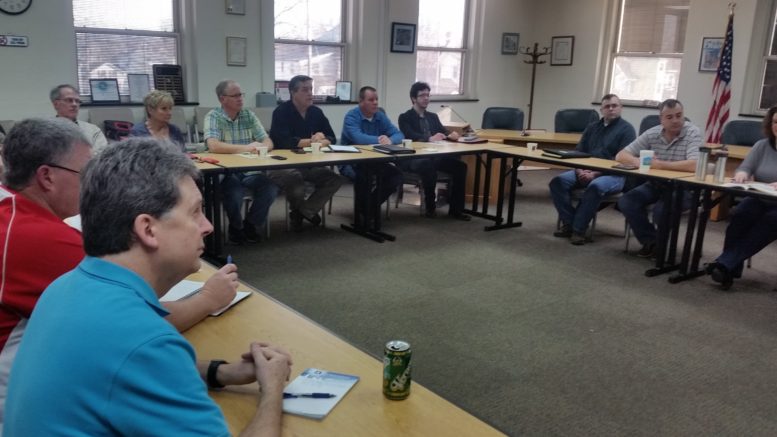By JAN LARSON McLAUGHLIN
BG Independent News
Armed with lots of coffee and doughnuts, Bowling Green City Council and administration officials spent three hours Saturday morning going over strategic plans for the city.
The annual planning meeting is an opportunity for “casual interaction,” council president Mike Aspacher explained. “It’s to step away from the things we are doing on a day-to-day basis and look forward to the big picture things.”
After hours of discussion, council members offered their goals for the next year. Eventually, their ideas will be narrowed down to three primary goals.
Following is a list of the priorities making the big list:
- Community Action Plan completion
- East Wooster Street improvements
- General fund revenue enhancement
- City charter review
- New city administration building
- New city cemetery
- Diversity of job creation
- Complete Streets progress
- Park space for children in northeast corner of city
- Food truck provisions
(More stories will follow on specifics discussed at the strategic planning meeting.)
City Council talked about goals they met last year. The city was able to check off its list the sustainable energy goal with the completion of the solar field. “That’s a huge feather in our cap,” Municipal Administrator Lori Tretter said.
The city also made progress on its Community Action Plan and the downtown green space plans.
Plans for improvements to the East Wooster Street corridor are also moving ahead. Decisions will have to be made by city officials if they want to make the roundabouts at Interstate 75 more attractive with decorative street lighting and cobblestone paving. Efforts are also being made to require parking buffers along East Wooster businesses to make them more attractive.
So what’s next?
City officials talked about the “stagnant” city revenue over the last 10 years – primarily due to state funding cuts that have eaten up any income tax revenue gains the city made. So the city is looking at ways to grow its revenue, with some proposals expected soon, according to Finance Director Brian Bushong.
City officials are also keeping a close eye on decisions at the state level that will affect the city budget. One proposal in the state budget bill changes the collection of business income tax, so the state keeps 1 percent before sending it to cities.
Council members Bob McOmber and Sandy Rowland said State Senator Randy Gardner, R-Bowling Green, seems to understand the problems state cuts have created for municipalities. Rowland suggested that State Rep. Theresa Gavarone, R-Bowling Green, be asked to talk with council about state changes that could impact the city.
Council member Daniel Gordon said Bowling Green is “hamstrung” by actions of the state.
“It’s really holding us back,” he said. “It prevents us from taking on projects the city want to do.”
Mayor Dick Edwards said there seems to be a “real disconnect” between the state wanting economic development, but not realizing that local government needs funding to help create that development.
“That’s what our revenue enhancement discussion is about,” McOmber said of the state funding losses. “That funding’s not coming back.”
At the strategic planning meeting, other items discussed included:
- Aging building issues at the city administration building and senior center. It was noted by Tretter that at least no bats showed up for the strategic planning session.
- Assistant Municipal Administrator Joe Fawcett said he is working on a city fee update, that will evaluate fees, some which were adopted as far back as 1965. Fawcett said he would like to make the fee structure more accessible and user-friendly for citizens.
- Public Works Director Brian Craft talked about evaluation of services. Replacement of a city garbage truck costs about $250,000. The city has six trucks that last about 10 years before needing to be replaced. Craft talked about the possibility of charging fees for picking up large items and for collecting brush, and about encouraging residents to mulch or compost their leaves since it is so costly for the city to pick them up every fall.
- Bushong reported the city will be handling contract negotiations with five labor unions this year.
- Gordon talked about the need for Bowling Green to “diversify our job portfolio” and add more creative type jobs, to attract more young people. Edwards said the city has all types of high-tech jobs. “We are very diversified, but we could be more diversified,” the mayor said.
- Edwards suggested it’s time to review the city charter which hasn’t been done since 2000. “Is our system of government working the way we all hoped,” he asked.
- The mayor also suggested the city revisit the historic preservation process. Other cities have experienced great success will such programs, but Bowling Green’s was shot down because misinformation caused people to think it was going to be “heavy-handed,” Edwards said.
- Gordon suggested that the Complete Streets effort needs a “road map,” and needs to take into consideration not just bike routes but also sidewalks and safe routes to schools.
- Planning Director Heather Sayler said plans are progressing on the Community Action Plan, with a rough draft expected in June.
- The Court Street Connects festival, set for April 22, will include courthouse tours, a temporary bike lane, fire station open house and student music on porches.
- An international town-gown organization summit will be held in Bowling Green in 2018.
- A renters guide is being released for off-campus students.
Other topics discussed during the strategic planning meeting included Oak Grove Cemetery running out of plots, the deteriorating buildings in City Park, planning for the city’s downtown green space, updates from the fire and police divisions, and the city’s new Good Neighbor Guide. Separate stories will appear on those issues.

